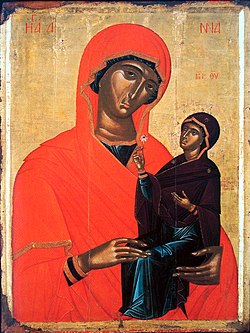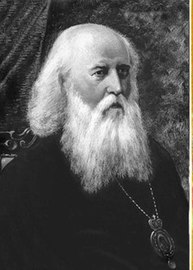Top Qs
Timeline
Chat
Perspective
September 9 (Eastern Orthodox liturgics)
From Wikipedia, the free encyclopedia
Remove ads
September 8 - Eastern Orthodox liturgical calendar - September 10

All fixed commemorations below celebrated on September 22 by Orthodox Churches on the Old Calendar.[note 1]
For September 9th, Orthodox Churches on the Old Calendar commemorate the Saints listed on August 27.
Feasts
Saints
- Holy and Righteous Ancestors of God Joachim[4] and Anna[5] (parents of the Theotokos).[1][6][7][note 2]
- Venerable Theophanes, Confessor and Faster, of Mount Diabenos (299)[1][7][8][9]
- Martyr Chariton, by the sword.[7][10][11]
- Martyr Severian of Sebaste (320)[1][7][12][13][note 3]
- Saint Rufus, Bishop of Thessaloniki from 407 (434)[15]
- Saint Agathocles of Koroni, Bishop of Koroni and a father of the Third Ecumenical Council (5th century)[16]
Remove ads
Pre-Schism Western saints
- Martyrs Hyacinth, Alexander and Tiburtius, martyrs in the Sabine country in Italy, about thirty miles from Rome.[17][note 4]
- Saint Kieran of Clonmacnoise (Ciaran, Kyran), one of the Twelve Apostles of Ireland and first Abbot of Clonmacnoise (c. 545)[1][2][14][17][18][19][note 5]
- Saint Osmanna (Argariarga), a holy virgin who left Ireland for Brittany and became an anchoress in a hermitage near Saint-Brieuc (c. 650)[17]
- Saint Omer (Audomarus), Bishop of Therouanne (670)[1][2][14][17][note 6]
- Saint Bettelin (Bertram), Hermit of Crowland (8th century)[2][17][note 7]
- Saint Wulfhilda of Barking, Abbess of Barking, Abbess of Horton, both in England (c. 1000)[2][17][note 8]
Post-Schism Orthodox saints
- Blessed Nicetas the Hidden, of Constantinople (12th century)[1][2][3][21]
- Venerable Joseph, founder of Volokolamsk (Volotsk) Monastery, Wonderworker (1515)[1][2][3][7][22][23]
- Venerable Joachim, founder of Opochka Monastery, Pskov (c. 1550)[1][2]
- Saint Joachim, monk of the St. Nicholas-Shartomsk Monastery in Suzdal (1625)[1]
- Saint Cyriacus of Tazlau Monastery, Moldavia (1660)[1]
- Venerable Onuphrius of Vorona, Moldavia (1789)[1][2][3][note 9]
New martyrs and confessors
- New Hieromartyrs Gregory Garyev,[24] Priest and Alexander Ipatov,[25] Deacon (1918)[2][3]
- New Hieromartyr Zachariah (Lobov), Archbishop of Voronezh (1937)[1][2][3][26][note 10]
- New Hieromartyrs Sergius Uklonsky, Joseph Arkharov,[27] Alexis Uspensky,[28] Priests (1937)[2][3]
- New Hieromartyr Dmitry Troitsky, Deacon (1937)[3][29]
- New Martyr Basil Shikalov (1937)[2][3][30]
- New Hieromartyr Andronicus (Surikov), Hieromonk, of Moscow (1938)[1][2][3][31]
- New Hieromartyr Alexander Vinogradov, Priest (1942)[2][3]
Remove ads
Other commemorations
- Commemoration of the Third Ecumenical Council (431)[1][3][7][32][33][note 11]
- Uncovering and Translation of the Relics (1896) of St. Theodosius, Archbishop of Chernigov (1696)[1][2][3][35][note 12]
- Synaxis of the Elders of the Glinsk Monastery:[36][37]
- Venerable Vasily (Kishkin)
- Venerable Philaret (Danilovsky)
- Venerable Theodoty (Levchenko)
- Venerable Makary (Sharov)
- Venerable Martiry (Kirichenko)
- Venerable Evfimy (Lyubimchenko)
- Venerable Dosithy (Kolchenkov)
- Venerable Iliadore (Golovantsky)
- Venerable Innokenty (Stepanov)
- Venerable Luke (Shvets)
- Venerable Archipy (Shestakov)
- Venerable Ioanniky (Gomolko)
- Venerable Seraphim (Amelin)
- Venerable Adronik (Lukash)
- Venerable Sraphim (Romantsov)
- Venerable Zinovy (Mazhugi), Metropolitan of Tetritsqaro (Seraphim in the schema).[36]
- Repose of Elder Joachim of St. Anne’s Skete, Mount Athos (1950)[1]
- Translation of the Relics (1992) of St. Gabriel of Białystok[38]
Remove ads
Icon gallery
- St. Anna.
- St. Severian of Sebaste, one of the Forty Martyrs of Sebaste.
- Venerable Joseph, founder of Volokolamsk Monastery.
- Relics of St. Onuphrius of Vorona, Moldavia.
- Venerable Onuphrius of Vorona, Moldavia.
- New Hieromartyr Zachariah (Lobov), Archbishop of Voronezh.
- St. Theodosius, Archbishop of Chernigov.
Remove ads
Notes
- The notation Old Style or (OS) is sometimes used to indicate a date in the Julian Calendar (which is used by churches on the "Old Calendar").
The notation New Style or (NS), indicates a date in the Revised Julian calendar (which is used by churches on the "New Calendar"). - "At Sebaste, St. Severian, a soldier of the emperor Licinius. For frequently visiting the Forty Martyrs whilst they were in prison, he was suspended in the air with a stone tied to his feet by order of the governor Lysias, and being scourged and torn with whips, yielded up his soul in the midst of torments."[14]
- Called 'The Younger'. He was born in Connacht, and was trained in the monastic life by St Finian of Clonard, one of the 'Twelve Apostles of Ireland'. He later founded Clonmacnois in West Meath and gave his monks an ascetic rule, 'The Law of Kieran'.
- Born near Constance in Switzerland, he became a monk at Luxeuil and after some twenty years Bishop of Thérouanne in the north of France. In order to enlighten the region, St Omer covered the area with monasteries. The saint himself helped found the monastery of Sithin, around which grew up the town now known as Saint Omer.
- Disciple of St Guthlac of Crowland in England. He lived there with companions under the first abbot, Kenulf.
- "ST. WULFILDA was of a noble English family, and built and endowed with her own estate the Abbey of Horton, in Dorsetshire. When the Abbey of Barking was reconstituted, after the dilapidations of the Danes, by the zeal of King Edgar, Wulfilda was appointed Abbess. Her rule was so blessed, that under her the house again flourished in its primitive perfection, in observance, and the holy lives of the religious. It appears that the Saint presided at the same time over this monastery and that of Horton. In the troubles which followed the death of Edgar, she was expelled by Queen Elfthrytha, but was restored, according to her own prediction, by Ethelred. Her venerated remains were buried at Barking; and when translated, thirty years later, were found wholly incorrupt, as though they had only just been interred. So many and so striking were the miracles wrought at her shrine, that St. Wulfilda received equal veneration with her great predecessors, St. Ethelburga and St. Hildelitha."[20]
- See: (in Romanian) Cuviosul Onufrie. Wikipedia. (Romanian Wikipedia).
- See: (in Russian) Захария (Лобов). Википедии. (Russian Wikipedia).
- See: (in Russian) Феодосий Черниговский. Википедии. (Russian Wikipedia).
Remove ads
References
Sources
Wikiwand - on
Seamless Wikipedia browsing. On steroids.
Remove ads










